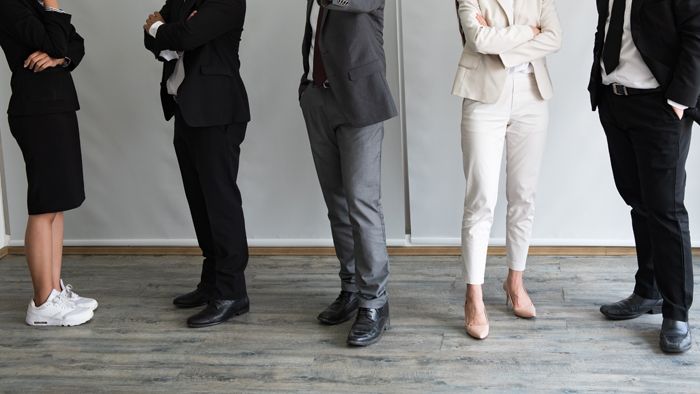Employment and fashion experts weigh in on this subject.

Casual attire may be the norm in many offices BUT it will never be the norm on a first interview. You where the best clothes you have that fit correctly and show you're a professional. For guys, suit and tie for business environments, jacket and tie for all others. Yes that includes interviewing for part time jobs. Double yes if you're an engineer - you may grok the technology but you'll need to dump the 'pen protector' image to get in.
For second and third interviews, I suggest you adopt the 'uniform' or image of the best dressed people you meet, unless you're meeting with the CEO, in which case back to creating that Cinderella at the ball look.
David Perry
Managing Partner
T: 613-236-6995 x114
http://www.perrymartel.com/
Formal wear is still the best choice -- especially on your first interview. When you get called back for second or third meeting - you can relax your attire a little to better match the company's work environment. Even if the workplace attire is very casual, I still recommend dressing the next level (business casual) at your various subsequent interviews. It illustrates professionalism, dedication, and a desire to be hired.
You really can't go wrong with the traditional business suit. Make sure the outfit looks good on you both with and without the jacket. This will come in handy, when trapped in a day-long interview. You will want to be able to take the jacket off with confidence. Another option is place a casual business outfit in your car as a backup.
The best way to communicate attire, is to be clear and specific in what you want them to wear.
Laura Rose
Author of the business ebook "Book of Answers: 105 Career Critical Situations"
www.LauraLeeRose.com
During the interview process an applicant first impression is important in creating the image of an ideal employee. Like any successful brand, you must consider all the elements to turn the interview into a job offer. A successful applicant will be 15 minutes early, have a few copies of their résumé, research the company, have key points to establish why they are the best candidate for the position, and dress professional. Even if the company has a business casual dress code, an applicant is not working there, and should wear a business suit. A recruiter may cover the dress code when scheduling the interview. They may tell the applicant to dress business casual. The men should then select dress slack, shirt and tie, or a blue blazer, dress shirt and khaki. The woman should select a dress, skirt with a sweater set, or a blazer over a skirt/dress. Both men and women should wear a business shoe. The items to avoid include, tight fitting clothing, revealing necklines, mini skirt/dress length, heavy after shave or perfume, oversize accessories, and loud prints.
Remember you are your brand. The interview is you time to showcase your brand. Make your brand creating a lasting impression for a second interview and keep it professional."
Diane Bogut
Author/Speaker/PT Radio Co-Host Employment-Inspiration-Dating
My view is more from the applicant than the interviewer, but the answer is "It depends." Different companies are going to have different expectations for what a candidate should wear for an interview, and frankly, it is up to the candidate to find out what that is.
How can they find out this information? The easiest way is to simply ask. When they make the appointment for the interview, just ask what the expected dress is. The interviewer will likely appreciate the initiative and assertiveness on the part of the candidate.
If that's not possible for whatever reason, ask a contact within the company. Presumably the candidate has done his or her homework, and has established a network connection with one or more people who work for the company. (This is an essential part of researching the company, so that the candidate can make informed suggestions about which of his or her skills can be put to good use in helping solve company problems and work toward company goals).
Failing that, you're left with stalking. Search for company photos on Google, or do a drive-by at the start or the end of the workday to see how people dress. Take this as a baseline, and dress one or two notches higher than what appears to be the average.
If not of these work, dress formally. It is a smaller mistake to be overdressed than underdressed, but both are mistakes. A candidate should research the target company and know a lot more about it than just the typical level of office dress before walking into the interview.
Alfred Poor, Ph.D.
America's Success Mentor for Young Employees
www.alfredpoorspeaker.com
I always recommend that candidates present themselves in a way that is professional, but not stiff. Naturally, this is tougher for women than for men. For example, a woman could wear a dark colored knee length dress with some subtle jewelry and a classy pair of heels. This type of look is always a smart choice because it can translate into a variety of different environments. (E.g., it's professional enough that it will hold its own if everyone else is wearing suits, but it is also fashionable enough that it will blend into an environment where people happen to dress more casual.)
Jackie Ducci I President
Ducci & Associates
www.ducciassociates.com
